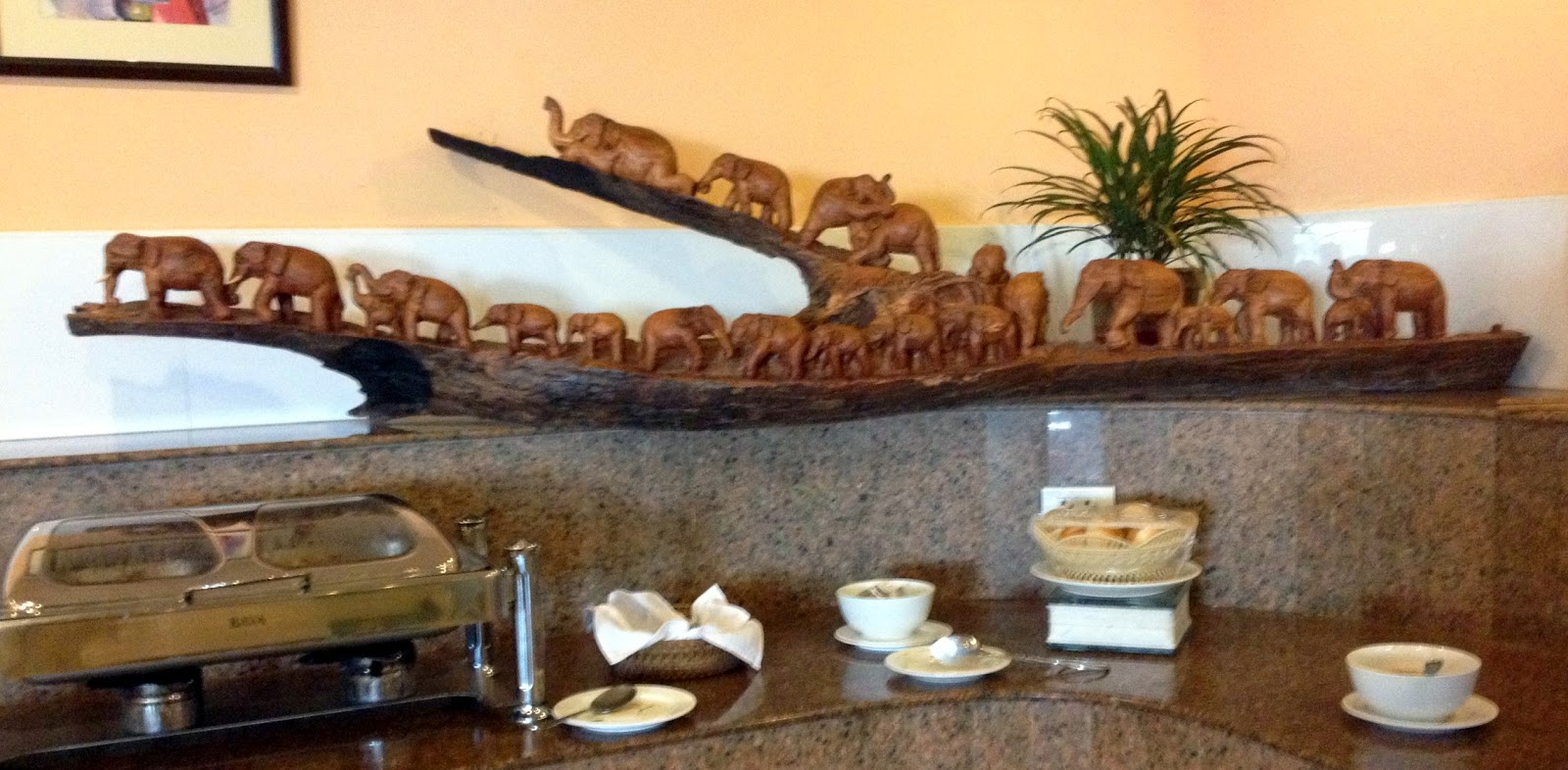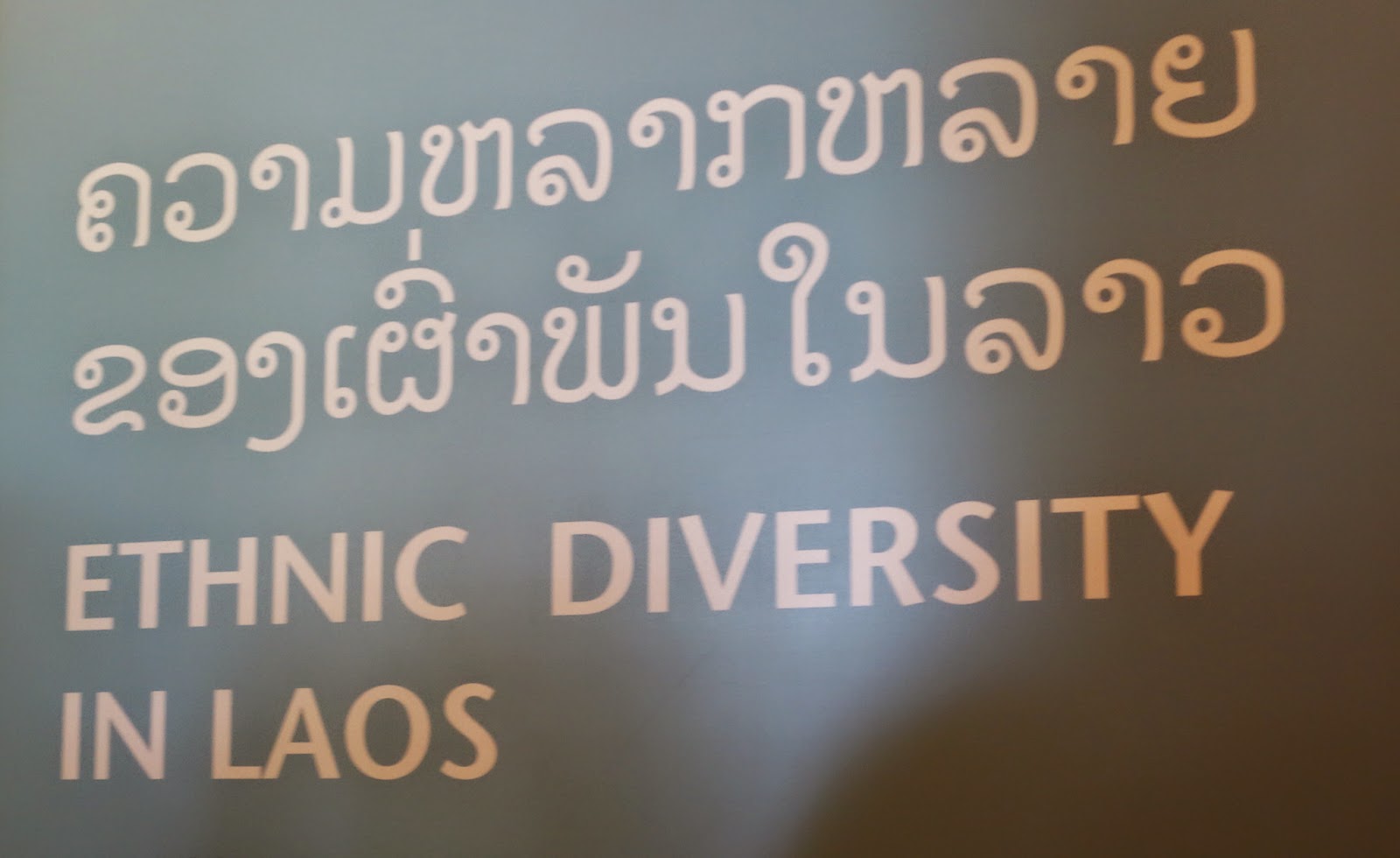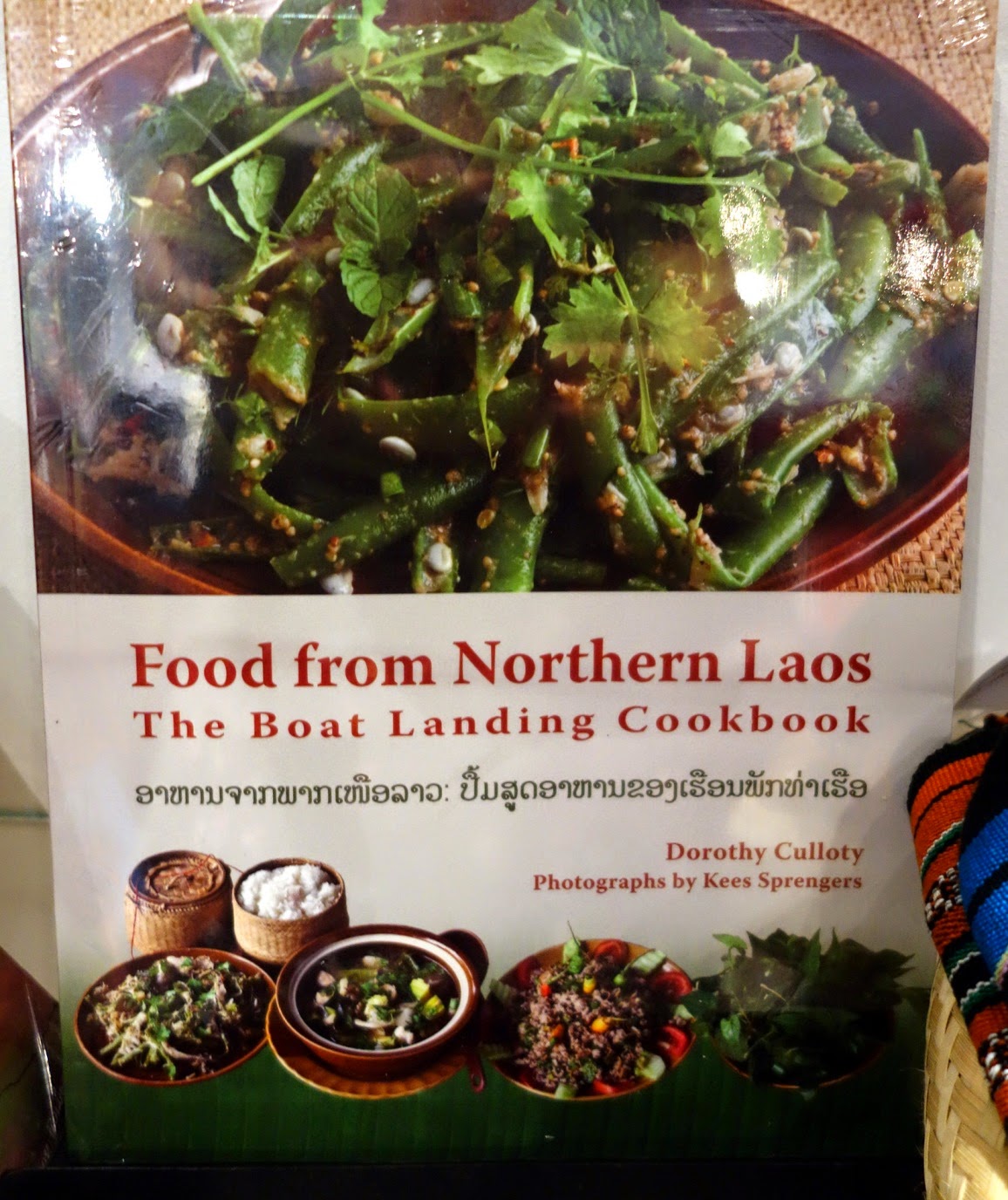Before heading on to Luang Prabang, we stopped in Pakse. Some just walked around the town but others (including Marcy and myself) shared a room in a VERY nice hotel so that we could shower and some could use the pool and so we all could enjoy a lovely buffet lunch.
The hotel was advertised in the Lao Airline magazine. I took a picture of the ad when we saw it on our flight.
The hotel had beautifully carved wooden furniture in the lobby. However, it wasn't very comfortable for sitting.
There were 2 computers for use in the lobby. Marcy got one to work and took advantage of it.
The buffet was lovely--both food and display. It had both Laotian and Western style food. I loved the wooden elephant pack carving above the buffet.
 |
| Sliced dragon fruit, rather mild (the outside of the fruit is much more exotic looking) |
We kept our luggage under 15 kilo (33 lb) as we were told that was the limit on the flight but it turned out to be 20 kilo, so even the two with large suitcases were OK).
Below is a picture of the Luang Prabang airport which we saw when we deplaned at sunset.
According to the Insight Guide on Laos and Cambodia, Luang Prabang is one of the "most intriguing, magical, and romantic cities in Asia." It is filled with old temples, quiet streets, and colonial buildings. It was added to UNESCOs World Heritage list in 1995. Two rivers, the Mekong and Nam Khan, intersect along the city. When I walked to where they intersected, I expected to find a busy, touristy area, and was delightfully surprised when I found a quiet, tree-lined street with a park area.
Marcy and I fell in love with the city and wished we could have stayed longer. It was the calmest and prettiest city that we visited on our trip. Also, because of the trees, we did not feel the heat as much.
In 1353, the first Lao Kingdom was consolidated and the capital was located where Luang Prabang is now. Two hundred years later, the capital was officially moved to Vientiane, but Luang Prabang remained a capital of an independent kingdom from 1694 until 1975 when the Pathet Lao took over the country. It currently has about 50,000 residents. It was the first place, however, where I noticed a heavy smoke smell in the area in early to mid-morning and from late afternoon into the early evening, both prime cooking time when charcoal from wood is the main way of cooking still.
You can read a bit more about the city at:
http://en.wikipedia.org/wiki/Luang_Prabang
and at
http://whc.unesco.org/en/list/479
We flew from Pakse to Luang Prabang in the late afternoon. I used the ATM at the airport and didn't realize until later than the machine did not give me back my debit card. With the incredible help of our CEO Kakada, the card was found in the machine but I chose to have it cancelled and found other ways to get money for the rest of the trip.
A tradition in Luang Probang is for the Buddhist monks and
novices to walk in silence and collect alms and food. Many of the monks are young novices. Most novices stay for a few years, often to
get a good basic education. It is one
way for boys from poor families to get a minimum of a high school education.
Each morning the monks go through specific streets of Luang
Probang, collecting food in pots which will be the basis for their meals. Sometimes they take money in a different
container, but most of the time they prefer/get food, especially balls of
rice. The local people kneel on mats,
form the rice into balls and place them in the container of each passing by
orange-dressed monk. The monks usually
have two meals a day, the last one being at noon. The basis for their food is from the
donations that they get on these early morning walks.
On our first full day in Luang Praboang, our CEO Kakada took us to a corner less frequented by
tourists. (We were told that some Asian
tourists really line up to take photos). We walked in the dark to early morning light to the quieter corner and waited about 20 minutes. Along the way we saw the following at the entry to a temple:
Kakada said that it was OK for us to take pictures from a distance so as
to be respectful and not get in the way of the monks as groups of monks make
their way through the streets.
Above, a woman is kneeling on her mat, waiting for the monks to come in small groups. The rice she has prepared is in the straw basket. Such baskets are available for purchase in the markets. The man beside her is dressed in white. He is not a monk, but a very religious person and his clothing colors reflect that. You can see the man in white and the woman on the mat below, handing out rice.I was across the street and cropped the photo. It was too dark to use a zoom with available light.
 |
| One of the few adult groups of monks passing through |
These monks are not to take money, but often there is one monk in the group with a special bag for money which is then used for necessities not donated.
At least 8 or 9 groups passed by as we stood on the corner. It was actually darker than the photos show as I edited the photos so that they could be seen.
After breakfast, we walked together to TAEC, the Traditional Arts and Ethnology Centre whose goal is to preserve cultural diversity in Laos. Its website is: http://www.taeclaos.org/
It was small but quite a gem as a museum. I was very impressed that all of the explanations were inn both Lao and English.
The museum is open Tuesdays through Sundays from 9 a.m. to 6 p.m. (and closed on Mondays).
The permanent exhibits explore the unique cultural aspects of four of Laos’ most well known ethnic minority groups: Akha, Hmong, Kmhmu and Tai Dam.
It was small but quite a gem as a museum. I was very impressed that all of the explanations were inn both Lao and English.
The 5.6 million people in Laos are distributed among 4 main ethnolinguistic groups, which represent over 100 ethnic groups and subgroups but some overlap so the distinctions are not necessarily clear.
The permanent exhibits explore the unique cultural aspects of four of Laos’ most well known ethnic minority groups: Akha, Hmong, Kmhmu and Tai Dam.
- Akha: The Diversity of An Ethnic Group demonstrates the subtle differences between subgroups of the Akha people, and features a stunning headdress made from over 300 pieces of Indochinese era silver.
- Hmong: New Years Celebrations offers an insight into the colourful courtship traditions of Hmong New Year.
- Tai Dam: Handmade Bedding Materials recreates a traditional Tai Dam bedroom including a handmade mosquito net.
- Kmhmu: Baskets and Back Strap Looms explores the versatility and beauty of bamboo basketry in a Kmhmu home.
The next section of the museum was about the (H)mong, the 4th largest ethnic group in Laos.
The largest group of Hmong live in China, but they have also migrated to Thailand, Vietnam and Laos, the latter mostly from 1810 to 1820. This adaptability to different places and their cultural resilience has kept them going through a history of economic changes, conflicts, and migrations. They are often known to reside in mountain tops, but that is often the case because of limited options. When they moved to Laos in the early 1800s, it was a relatively late migration and their choices were mostly limited to higher elevations. High mountain areas were also idea places to cultivate opium, a major cash crop at that time. In recent times, they have earned a lot of money by making traditional clothing and sending it to relatives overseas to resell. They can also earn money by sending herbal medicines and recorded music overseas.
I was beginning to feel spacy/weak from the returning sinus infection so my absorption of material at the museum was sketchy and I need to rely on the pictures I took for information. However, my picture taking was less organized than other times.
 |
The (H)mong 's celebration of the New Year, which can last up to ten days, is based on the lunar calendar, so it takes place between December and January. It is a special time to honor ancestors and spirits through rituals and offerings, and participate in games, feasts, shows, courtship, and bullfights.
Since the (H)mong must marry outside of their specific clan, this celebration is a good time for the youth to find mates. Unmarried men often travel to different villages for the celebrations, while mothers spend months making elaborate costumes for their children to wear. They often ask overseas relatives to send sequins and fabric to add to the costumes. While the sub-group costumes used to be unique, nowadays most prefer the ornate skirts, embroidery bags, and sashes of the (H)mong Njua.
Pov Pob is a famous ball-throwing game that they play and is a courting ritual. Unmarried men and women stand in parallel lines and toss cloth balls back and forth using just one hand. If one drops a ball, a traditional song is sung and an ornament from one's clothing is handed to one's throwing partner.
The next group described in TAEC is theTai Lue
In Nayang Tai village in the north of Luang Prabang province, every family has a loom under their home and every family grows cotton for weaving into cloth. Girls start learning to weave at an early age after watching and assisting their mothers and other female relatives with ginning, spinning and dyeing.Below are some of the steps in the production of cotton and cloth.
 |
| and the results |
Next come the Kmhmu. One of our guides was Khmu (the way he spelled it.)

The Kmhmu belong to the Mon-Khmer sub-branch of the Austroasiantic ethno-linguistic family. The latter are consider the original people of Laos. They are often called Lao Theung (Lao of the mountain slopes) as they probably moved to the higher elevations when the Tai people began to settle in the lowlands from about 1100 on.
They have a long history of bartering with their Tai neighbors, trading rice, forest products, basketry and labor for clothes, iron and other items.
The Khmu have clan affiliations but they don't have a long term genealogical value like the Hmong and Yao. Their clans are named for mammals, birds or wild plants.
The Kmhmu are amazing basket weavers. Baskets are made for many household and agricultural uses, including winnowing rice, holding rice, catching fish, or sheathing knives. They are mostly made from bamboo with rattan used for the rims and frames. The weaver chooses a different kind of bamboo based on strength, color and flexibility. We saw a variety of different kinds of bamboo growing on our trip.
After gathering the bamboo, it is treated by stripping, scraping, and sometimes soaking and drying it to make it pliable for weaving and to prevent insects attacking the end product. Weaving a smaller basket can take a day while weaving a large floor mat can take up to two weeks. Once completed, the baskets are smoked to preserve them and keep insects away.
 |
| Examples of Khmu baskets and weaving |
Because of where the Katu lived, during "Vietnam-American" war , many bombs were dropped by where they lived. Land mines were also there and the area was sprayed with defoliants, causing people to flee into forests from their villages. They were eventually resettled, and are now involved in more permanent agriculture. Single-family homes have replaced the longhouse, and homes are arranged more linearally then concentric. However, they do have more educational opportunities and access to electricity and clinics. They are also more involved in national life. They still maintain traditions along with the modern changes. Women weave textiles on backstrap looms, although they often buy materials to leave. And the communal hall remains the center of the the town's activities.
 |
| Backstrap weaving with synthetic threads |
 |
| Examples of Katu baskets |



















































No comments:
Post a Comment